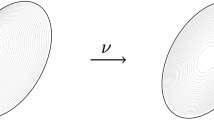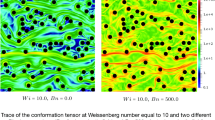Abstract
A new idea of using the parabolized stability equation (PSE) method to predict laminar-turbulent transition is proposed. It is tested in the prediction of the location of transition for compressible boundary layers on flat plates, and the results are compared with those obtained by direct numerical simulations (DNS). The agreement is satisfactory, and the reason for this is that the PSE method faithfully reproduces the mechanism leading to the breakdown process in laminar-turbulent transition, i.e., the modification of mean flow profile leads to a remarkable change in its stability characteristics.
Similar content being viewed by others
References
Huang Zhangfeng, Cao Wei, Zhou Heng. The mechanism of breakdown in laminar-turbulent transition of a supersonic boundary layer on a flat plate-temporal mode[J]. Science in China, Series G, 2005, 48(5):614–625.
Cao Wei, Huang Zhangfeng, Zhou Heng. Study of mechanism of breakdown in laminar-turbulent transition of supersonic boundary layer on flat plate[J]. Applied Mathematics and Mechanics (English Edition), 2006, 27(4):425–434. DOI:10.1007/s10483-006-0401-1
Cebeci T, Stewartson K. On stability and transition in three-dimensional flows[J]. AIAA Journal, 1980, 18(4):398–405.
Cebeci T, Shao J P, Chen H H, Chang K C. The preferred approach for calculating transition by stability theory[C]. In: Proceeding of International Conference on Boundary and Interior Layers, Toulouse, France: Institute for Numerical Computation and Analysis, 2004.
Crouch J D, Kosorygin V S, Ng L L. Modeling the effects of steps on boundary-layer transition[C]. In: Proceedings of the sixth IUTAM Symposium on Laminar-Turbulent Transition, Bangalore India: IUTAM, 2004.
Su Caihong, Zhou Heng. Stability analysis and transition prediction of hypersonic boundary layer over a blunt cone with small nose bluntness at zero angle of attack[J]. Applied Mathematics and Mechanics (English Edition), 2007, 28(5):563–572. DOI:10.1007/s10483-007-0501-1
Luo Jisheng, Wang Xinjun, Zhou Heng. Inherent mechanism of breakdown in laminar-turbulent transition of plane channel flows[J]. Science in China, Series G, 2005, 48(2):228–236.
Tang Hongtao, Luo Jisheng, Zhou Heng. Mechanics of breakdown in laminar-turbulent transition of incompressible boundary layer on a flat plate[J]. Transactions of Tianjin University, 2007, 13(2):79–87.
Li Ning. Investigation on transition of laminar-turbulent in a boundary layer on a flat plate based on the spatial model[D]. Ph D dissertation. Tianjin: Tianjin University, 2007 (in Chinese).
Bertolotti F P, Herbert Th, Spalart P R. Linear and nonlinear stability of the Blasius boundary layer[J]. Journal of Fluid Mechanics, 1992, 242(1):441–474.
Esfahanian V, Hejranfar K, Sabetghadam F. Linear and nonlinear PSE for stability analysis of the Blasius boundary layer using compact scheme[J]. Journal of Fluids Engineering, 2001, 123(3):545–550.
Herbert Th. Parabolized stability equations[J]. Annual Review of Fluid Mechanics, 1997, 29(1):245–283.
Bertolotti F P, Herbert Th. Analysis of the linear stability of compressible boundary layers using the PSE[J]. Theoretical and Computational Fluid Dynamics, 1991, 3(2):117–124.
Bertolotti F P. Compressible boundary layer stability analyzed with the PSE equations[R]. AIAA 22nd Fluid Dynamics, Plasma Dynamics and Lasers Conference, AIAA Paper 91-1637, Honolulu, HI, June 1991.
Hu S H, Zhong X. Nonparallel stability analysis of compressible boundary layer using 3-D PSE[R]. AIAA Paper 99-0813, 1999.
Chang C L, Malik M R, Erlebacher G, and Hussaini M Y. Compressible stability of growing boundary layers using parabolized stability equations[R]. AIAA Paper 91-1636, 1991.
Zhang Yongming, Zhou Heng. Verification of the parabolized stability equations for its application to compressible boundary layers[J]. Applied Mathematics and Mechanics (English Edition), 2007, 28(8):987–998. DOI:10.1007/s10483-007-0801-3
Zhang Yongming, Zhou Heng. PSE as applied to problems of secondary instability in supersonic boundary layers[J]. Applied Mathematics and Mechanics (English Edition), 2008, 29(1):1–8. DOI:10.1007/s10483-008-0101-7
Huang Zhangfeng. The mechanism of laminar-turbulent transition and the characteristics of turbulence in a supersonic boundary layer on a flat plate[D]. Ph D dissertation, Tianjin: Tianjin University, 2006 (in Chinese).
Author information
Authors and Affiliations
Corresponding author
Additional information
Contributed by ZHOU Heng
Project supported by the National Natural Science Foundation of China (Nos. 10632050, 90716007), and the Science Foundation of LIU Hui Center of Applied Mathematics of Nankai University and Tianjin university.
Rights and permissions
About this article
Cite this article
Zhang, Ym., Zhou, H. PSE as applied to problems of transition in compressible boundary layers. Appl. Math. Mech.-Engl. Ed. 29, 833–840 (2008). https://doi.org/10.1007/s10483-008-0701-8
Received:
Revised:
Published:
Issue Date:
DOI: https://doi.org/10.1007/s10483-008-0701-8




